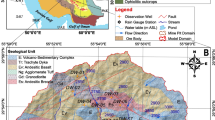Abstract
Groundwater modelling is a useful tool to forecast hydraulic heads, changes in groundwater levels and changes in concentrations such as in cases of pollutant plume evolution and evaluating of aquifer protection strategies. Also, modeling can be used to hindcast changes in concentrations. Over the years, several numerical methods have been employed for the development of groundwater flow and transport models with the most popular being the finite difference and finite element approaches. In the present work, a review of the groundwater flow and transport models is presented based on their numerical method approaches in a chronological order. Also, all phases of building a groundwater model and all required information in each phase are included. Finally, the most well-known and used commercial groundwater simulators for flow and transport are presented.
Similar content being viewed by others
References
Babu DK, Pinder GF, Niemi A, Ahlfeld DP, and Stothoff SA (1987) Chemical transport by three-dimensional groundwater flows. Princeton Technical Report 84-WR-3 (revised). Department of Civil Engineering, Princeton University, Princeton
Coppola EA, Rana AJ, Poulton MM, Szidarovszky F, Uhl VW (2005) A neural network model for predicting aquifer water level elevations. Ground Water 43:231–241
De Marsily G (1986) Quantitative hydrogeology: groundwater hydrology for engineers. Academic Press, New York
Diersch H-J (2014) FEFLOW – finite element modeling of flow, mass and heat transport in porous and fractured media. Springer, Berlin Heidelberg. doi:10.1007/978-3-642-38739-5
Feng S, Kang S, Huo Z, Chen S, Mao X (2008) Neural networks to simulate regional ground water levels affected by human activities. Ground Water 46:80–90
Fogg GE (1986) Groundwater flow and sand body interconnectedness in a thick multiple-aquifer system. Water Resour Res 22(5):679–694. doi:10.1029/WR022i005p00679
Gray WG (1984) Comparison of finite difference and finite element methods. In: Bear J, Corapcioglu MY (eds) Fundamentals of transport phenomena in porous media. Springer, Berlin, pp 899–952. doi:10.1007/978-94-009-6175-3_18
Huyakorn PS, Pinder GF (1983) Computational methods in subsurface flow. Academic Press, New York
Kumar CP (2015) Modeling of groundwater flow and data requirements. Int Journal Mod Sci Eng Technol 2(2):18–27
Lallahem S, Mania J, Hani A, Najjar Y (2005) On the use of neural networks to evaluate groundwater levels in fractured media. J Hydrol 307:92–111
Liggett JA (1987) Advances in the boundary integral equation method in subsurface flow. Water Resour Bull 23(4):637–651. doi:10.1111/j.1752-1688.1987.tb00838.x
Liggett JA, Liu PLF (1983) The boundary integral equation method for porous media flow. Allen and Unwin, London
McDonald MG, Harbaugh AW (2003) The history of MODFLOW. Ground Water 41(2):280–283. doi:10.1111/j.1745-6584.2003.tb02591.x
Mercer JW, Faust CR (1981) Ground-water modelling. National Water Well Association, Worthington
Narasimhan TN, Witherspoon PA (1978) Numerical model for saturated-unsaturated flow in deformable porous media: 3. Appl Water Resour Res 14(6):1017–1034. doi:10.1029/WR014i006p01017
Nayak P, Rao Y, Sudheer K (2006) Groundwater level forecasting in a shallow aquifer using artificial neural network approach. Water Resour Manag 20:77–90
Nikolos IK, Stergiadi M, Papadopoulou MP, Karatzas GP (2008) Artificial neural networks as an alternative approach to groundwater numerical modelling and environmental design. Hydrol Process 22:3337–3348
Olivares JL (2001) Argus ONE-PTC interface, ver. 2.2, User's manual. Research Center for Groundwater Remediation Design, University of Vermont, Burlington
Pinder GF (1999) Lecture notes. Department of civil and environmental engineering. University of Vermont, Burlington
Pinder GF, Bredehoeft JD (1968) Application of the digital computer for aquifer evaluation. Water Resour Res 4:1069–1093. doi:10.1029/WR004i005p01069
Pinder GF, Gray WG (1977) Finite element simulation in surface and subsurface hydrology. Academic Press, New York
Reeves M, Ward DS, Johns ND, Cranwell RM (1986) Theory and implementation for SWIFT II, the Sandia waste-isolation flow and mass transport model for fracture media. Technical Report NUREG/CR-3328. Sandia National Laboratories, Albuquerque
Remson I, Hornberger GM, Molz FJ (1971) Numerical methods in subsurface hydrology. Wiley, New York
Tapoglou E, Karatzas GP, Trichakis IC, Varouchakis EA (2014) A spatio-temporal hybrid neural network-kriging model for groundwater level simulation. J Hydrol 519:3193–3203. doi:10.1016/j.jhydrol.2014.10.040
Trefry MG, Muffels C (2007) FEFLOW: a finite-element ground water flow and transport modeling tool. Ground Water 45(5):525–528. doi:10.1111/j.1745-6584.2007.00358.x
Trichakis IC, Nikolos IK, Karatzas GP (2009) Optimal selection of artificial neural network parameters for the prediction of a karstic aquifer’s response. Hydrol Process 23:2956–2969
Vatnaskil (1998a) Groundwater flow and contaminant transport model - user’s manual. Vatnaskil Consulting Engineers, Iceland, p 69
Vatnaskil (1998b) Groundwater flow and contaminant transport model. Vatnaskil Consulting Engineers, Iceland, p 86
Voss CI (1984) A finite-element simulation model for saturated-unsaturated, fluid density-dependent ground-water flow with energy transport or chemically-reactive single-species solute transport. Water-resources investigations report 84-4369. U.S. Geological Survey
Wang JF, Anderson MP (1982) Introduction to groundwater modelling. Freeman, San Francisco
Welch JE, Harlow FH, Shannon JP, Daly BJ (1966) The MAC method - a computing technique for solving viscous, incompressible, transient fluid-flow problems involving free surfaces. Report LA-3425. Los Alamos scientific laboratory, Los Alamos
Yeh GT (1987) 3DFEMWATER: a three-dimensional finite element model of water flow through saturated-unsaturated media. Report ORNL-6368, Oak Ridge National Lab, TN
Yeh GT (1990) 3DLEWASTE: a hybrid Lagrangian-Eulerian finite element model of waste transport through saturated-unsaturated media. PSU Technical Report. Department of Civil Engineering, The Pennsylvania State University, University Park
Yeh GT, Ward DS (1981) FEMWASTE: a finite-element model of waste transport through saturated-unsaturated porous media. Report ORNL-5601, Oak Ridge National Lab, TN
Yeh GT, Strobl RO, Cheng JR (1994) 2DFEMFAT: a two-dimensional finite element model of density-dependent flow and transport through saturated-unsaturated porous media: version 2.0. Department of Civil and Environmental Engineering, the Pennsylvania State University, University Park
Zheng C (1990) MT3D, a modular three-dimensional transport model for simulation of advection, dispersion and chemical reactions of contaminants in groundwater systems. Report to the U.S. Environmental Protection Agency, SS Papadopulos & Associates, MA
Zienkiewicz OC (1977) The finite element method, 3rd edn. McGraw-Hill, London
Author information
Authors and Affiliations
Corresponding author
Rights and permissions
About this article
Cite this article
Karatzas, G.P. Developments on Modeling of Groundwater Flow and Contaminant Transport. Water Resour Manage 31, 3235–3244 (2017). https://doi.org/10.1007/s11269-017-1729-z
Received:
Accepted:
Published:
Issue Date:
DOI: https://doi.org/10.1007/s11269-017-1729-z




